height MAZDA MODEL RX 8 2006 Owners Manual (in English)
[x] Cancel search | Manufacturer: MAZDA, Model Year: 2006, Model line: MODEL RX 8, Model: MAZDA MODEL RX 8 2006Pages: 434
Page 16 of 434
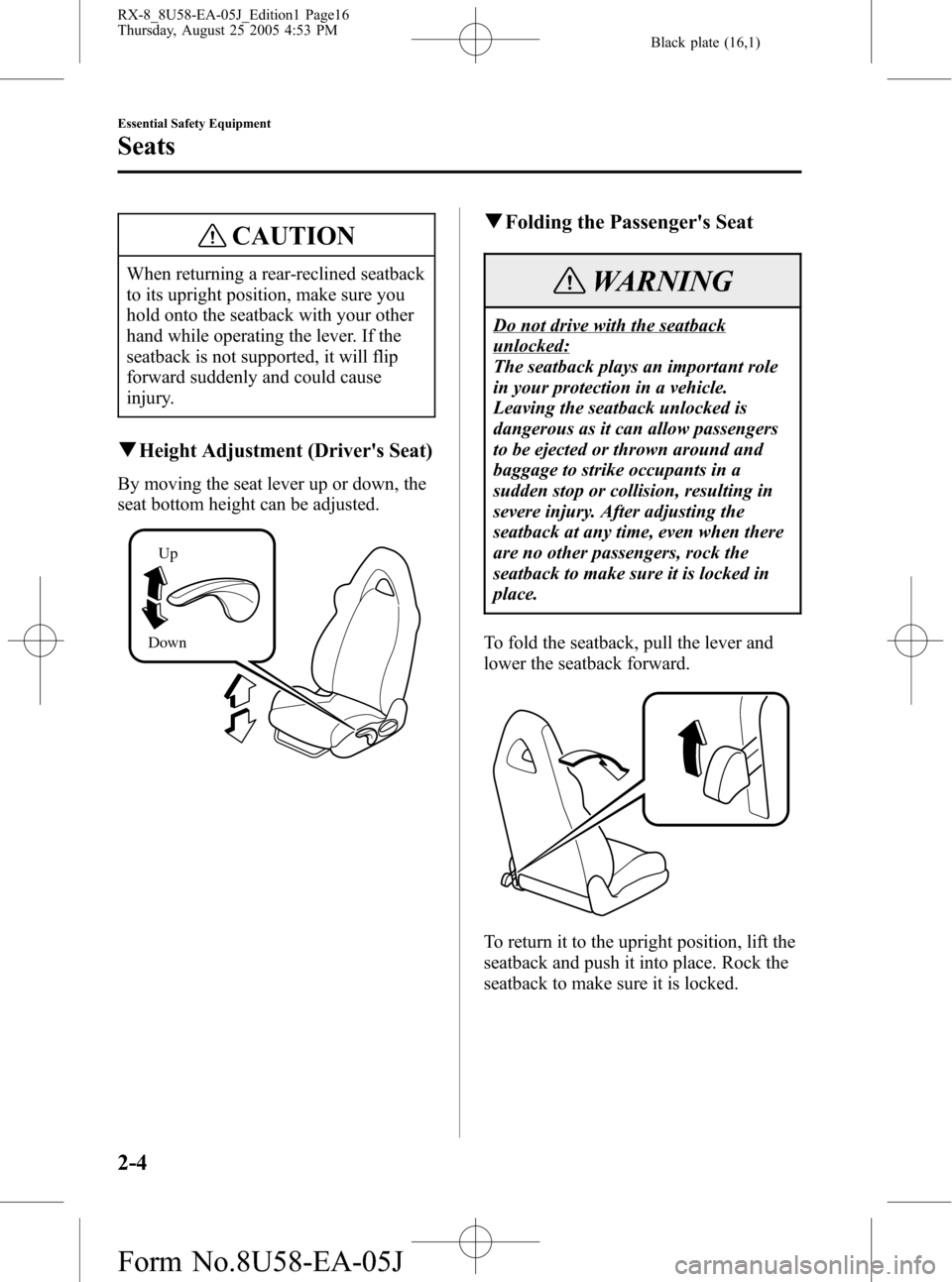
Black plate (16,1)
CAUTION
When returning a rear-reclined seatback
to its upright position, make sure you
hold onto the seatback with your other
hand while operating the lever. If the
seatback is not supported, it will flip
forward suddenly and could cause
injury.
qHeight Adjustment (Driver's Seat)
By moving the seat lever up or down, the
seat bottom height can be adjusted.
Up
Down
qFolding the Passenger's Seat
WARNING
Do not drive with the seatback
unlocked:
The seatback plays an important role
in your protection in a vehicle.
Leaving the seatback unlocked is
dangerous as it can allow passengers
to be ejected or thrown around and
baggage to strike occupants in a
sudden stop or collision, resulting in
severe injury. After adjusting the
seatback at any time, even when there
are no other passengers, rock the
seatback to make sure it is locked in
place.
To fold the seatback, pull the lever and
lower the seatback forward.
To return it to the upright position, lift the
seatback and push it into place. Rock the
seatback to make sure it is locked.
2-4
Essential Safety Equipment
Seats
RX-8_8U58-EA-05J_Edition1 Page16
Thursday, August 25 2005 4:53 PM
Form No.8U58-EA-05J
Page 18 of 434
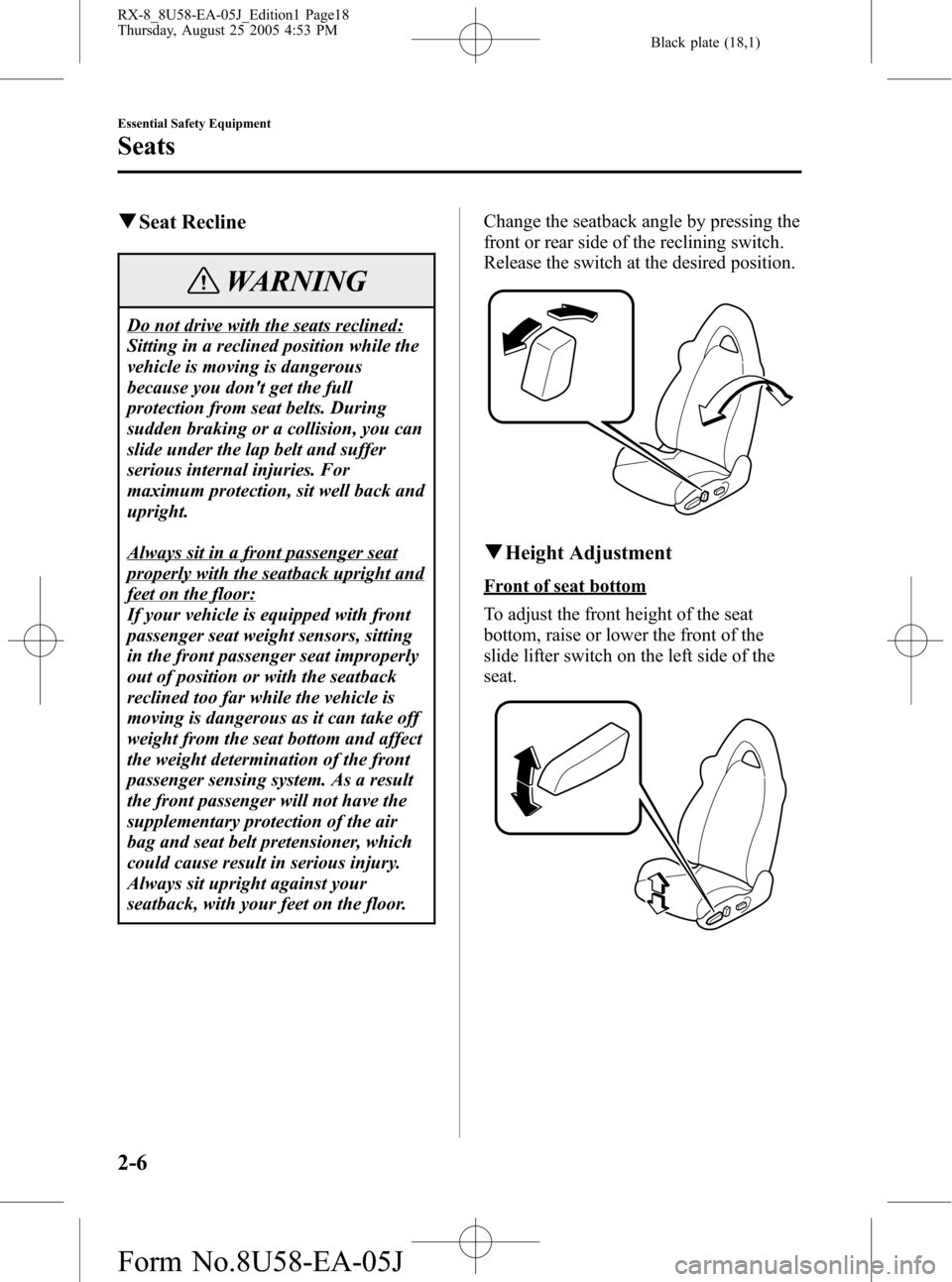
Black plate (18,1)
qSeat Recline
WARNING
Do not drive with the seats reclined:
Sitting in a reclined position while the
vehicle is moving is dangerous
because you don't get the full
protection from seat belts. During
sudden braking or a collision, you can
slide under the lap belt and suffer
serious internal injuries. For
maximum protection, sit well back and
upright.
Always sit in a front passenger seat
properly with the seatback upright and
feet on the floor:
If your vehicle is equipped with front
passenger seat weight sensors, sitting
in the front passenger seat improperly
out of position or with the seatback
reclined too far while the vehicle is
moving is dangerous as it can take off
weight from the seat bottom and affect
the weight determination of the front
passenger sensing system. As a result
the front passenger will not have the
supplementary protection of the air
bag and seat belt pretensioner, which
could cause result in serious injury.
Always sit upright against your
seatback, with your feet on the floor.Change the seatback angle by pressing the
front or rear side of the reclining switch.
Release the switch at the desired position.
qHeight Adjustment
Front of seat bottom
To adjust the front height of the seat
bottom, raise or lower the front of the
slide lifter switch on the left side of the
seat.
2-6
Essential Safety Equipment
Seats
RX-8_8U58-EA-05J_Edition1 Page18
Thursday, August 25 2005 4:53 PM
Form No.8U58-EA-05J
Page 19 of 434
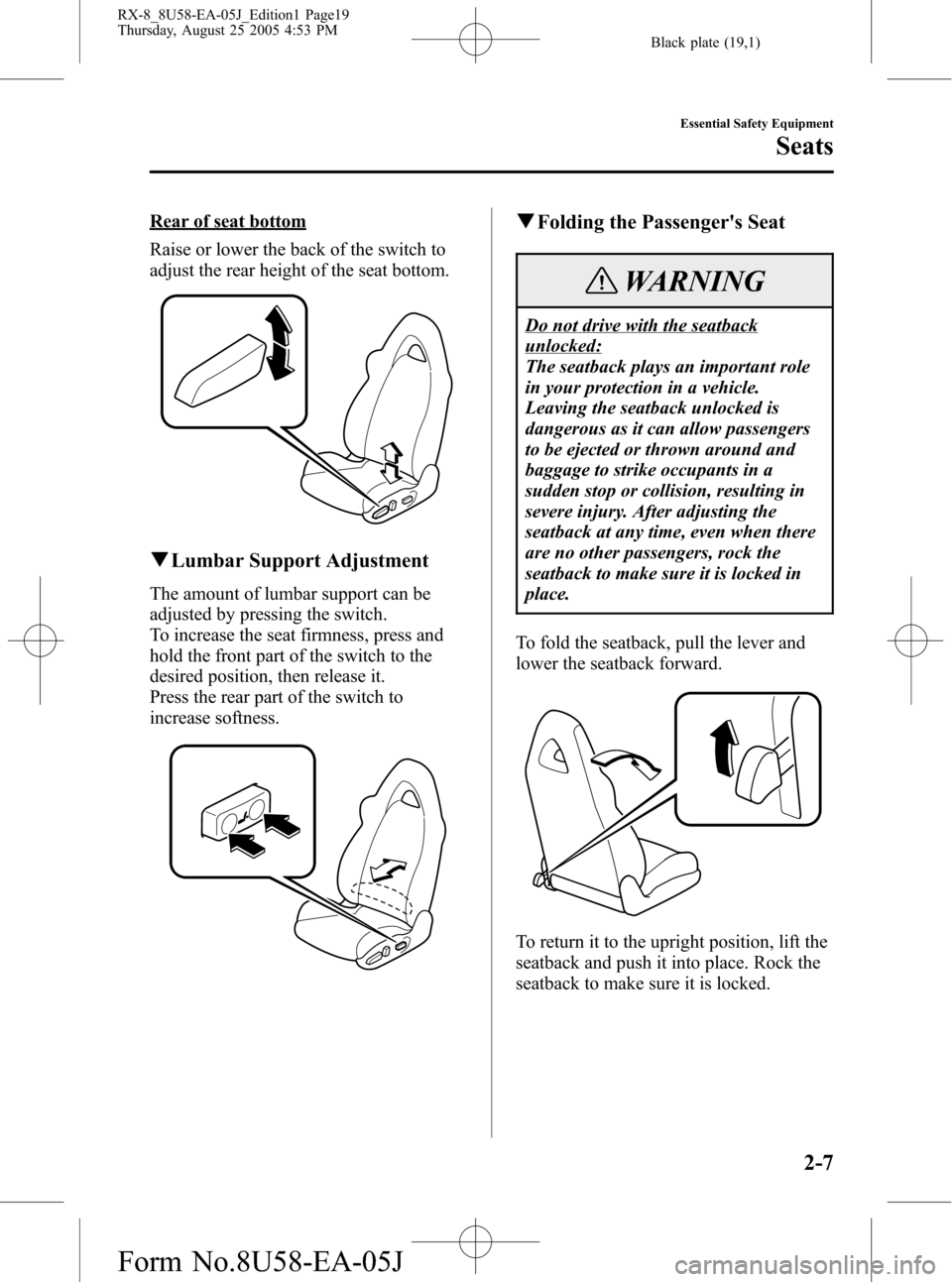
Black plate (19,1)
Rear of seat bottom
Raise or lower the back of the switch to
adjust the rear height of the seat bottom.
qLumbar Support Adjustment
The amount of lumbar support can be
adjusted by pressing the switch.
To increase the seat firmness, press and
hold the front part of the switch to the
desired position, then release it.
Press the rear part of the switch to
increase softness.
qFolding the Passenger's Seat
WARNING
Do not drive with the seatback
unlocked:
The seatback plays an important role
in your protection in a vehicle.
Leaving the seatback unlocked is
dangerous as it can allow passengers
to be ejected or thrown around and
baggage to strike occupants in a
sudden stop or collision, resulting in
severe injury. After adjusting the
seatback at any time, even when there
are no other passengers, rock the
seatback to make sure it is locked in
place.
To fold the seatback, pull the lever and
lower the seatback forward.
To return it to the upright position, lift the
seatback and push it into place. Rock the
seatback to make sure it is locked.
Essential Safety Equipment
Seats
2-7
RX-8_8U58-EA-05J_Edition1 Page19
Thursday, August 25 2005 4:53 PM
Form No.8U58-EA-05J
Page 45 of 434
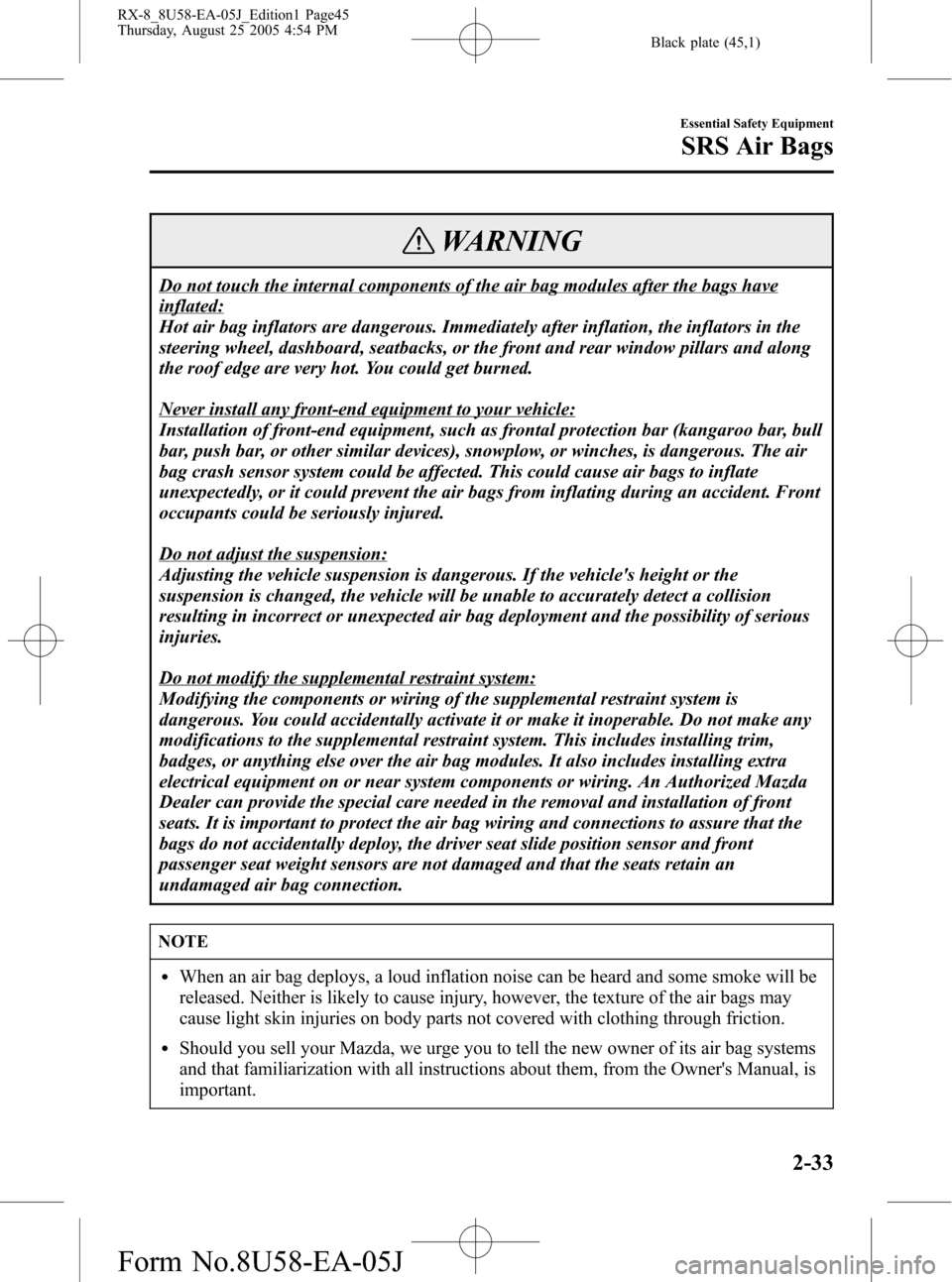
Black plate (45,1)
WARNING
Do not touch the internal components of the air bag modules after the bags have
inflated:
Hot air bag inflators are dangerous. Immediately after inflation, the inflators in the
steering wheel, dashboard, seatbacks, or the front and rear window pillars and along
the roof edge are very hot. You could get burned.
Never install any front-end equipment to your vehicle:
Installation of front-end equipment, such as frontal protection bar (kangaroo bar, bull
bar, push bar, or other similar devices), snowplow, or winches, is dangerous. The air
bag crash sensor system could be affected. This could cause air bags to inflate
unexpectedly, or it could prevent the air bags from inflating during an accident. Front
occupants could be seriously injured.
Do not adjust the suspension:
Adjusting the vehicle suspension is dangerous. If the vehicle's height or the
suspension is changed, the vehicle will be unable to accurately detect a collision
resulting in incorrect or unexpected air bag deployment and the possibility of serious
injuries.
Do not modify the supplemental restraint system:
Modifying the components or wiring of the supplemental restraint system is
dangerous. You could accidentally activate it or make it inoperable. Do not make any
modifications to the supplemental restraint system. This includes installing trim,
badges, or anything else over the air bag modules. It also includes installing extra
electrical equipment on or near system components or wiring. An Authorized Mazda
Dealer can provide the special care needed in the removal and installation of front
seats. It is important to protect the air bag wiring and connections to assure that the
bags do not accidentally deploy, the driver seat slide position sensor and front
passenger seat weight sensors are not damaged and that the seats retain an
undamaged air bag connection.
NOTE
lWhen an air bag deploys, a loud inflation noise can be heard and some smoke will be
released. Neither is likely to cause injury, however, the texture of the air bags may
cause light skin injuries on body parts not covered with clothing through friction.
lShould you sell your Mazda, we urge you to tell the new owner of its air bag systems
and that familiarization with all instructions about them, from the Owner's Manual, is
important.
Essential Safety Equipment
SRS Air Bags
2-33
RX-8_8U58-EA-05J_Edition1 Page45
Thursday, August 25 2005 4:54 PM
Form No.8U58-EA-05J
Page 305 of 434
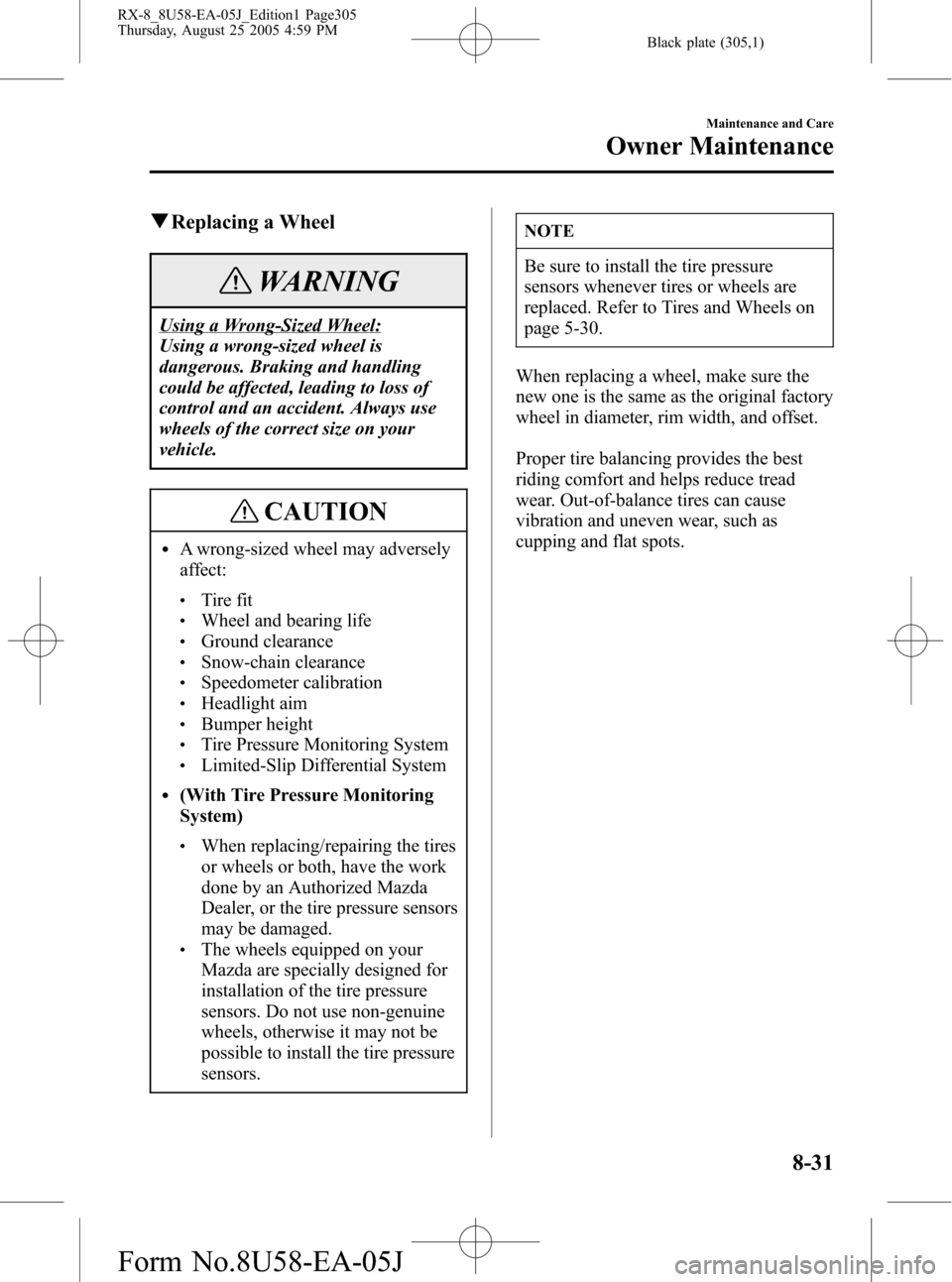
Black plate (305,1)
qReplacing a Wheel
WARNING
Using a Wrong-Sized Wheel:
Using a wrong-sized wheel is
dangerous. Braking and handling
could be affected, leading to loss of
control and an accident. Always use
wheels of the correct size on your
vehicle.
CAUTION
lA wrong-sized wheel may adversely
affect:
lTire fitlWheel and bearing lifelGround clearancelSnow-chain clearancelSpeedometer calibrationlHeadlight aimlBumper heightlTire Pressure Monitoring SystemlLimited-Slip Differential System
l(With Tire Pressure Monitoring
System)
lWhen replacing/repairing the tires
or wheels or both, have the work
done by an Authorized Mazda
Dealer, or the tire pressure sensors
may be damaged.
lThe wheels equipped on your
Mazda are specially designed for
installation of the tire pressure
sensors. Do not use non-genuine
wheels, otherwise it may not be
possible to install the tire pressure
sensors.
NOTE
Be sure to install the tire pressure
sensors whenever tires or wheels are
replaced. Refer to Tires and Wheels on
page 5-30.
When replacing a wheel, make sure the
new one is the same as the original factory
wheel in diameter, rim width, and offset.
Proper tire balancing provides the best
riding comfort and helps reduce tread
wear. Out-of-balance tires can cause
vibration and uneven wear, such as
cupping and flat spots.
Maintenance and Care
Owner Maintenance
8-31
RX-8_8U58-EA-05J_Edition1 Page305
Thursday, August 25 2005 4:59 PM
Form No.8U58-EA-05J
Page 342 of 434

Black plate (342,1)
Tire Labeling
Federal law requires tire manufacturers to place standardized information on the sidewall of
all tires. This information identifies and describes the fundamental characteristics of the tire
and also provides a tire identification number for safety standard certification and in case of
a recall.
qInformation on Passenger Vehicle Tires
Please refer to the diagram below.
1. TIN: U.S. DOT tire identification number
2. Passenger car tire
3. Nominal width of tire in millimeters
4. Ratio of height to width (aspect ratio)
5. Radial
6. Rim diameter code
7. Load index & speed symbol
8. Severe snow conditions
9. Tire ply composition and materials used
10. Max. load rating
9-18
Customer Information and Reporting Safety Defects
Tire Information (U.S.A.)
RX-8_8U58-EA-05J_Edition1 Page342
Thursday, August 25 2005 5:0 PM
Form No.8U58-EA-05J
Page 343 of 434
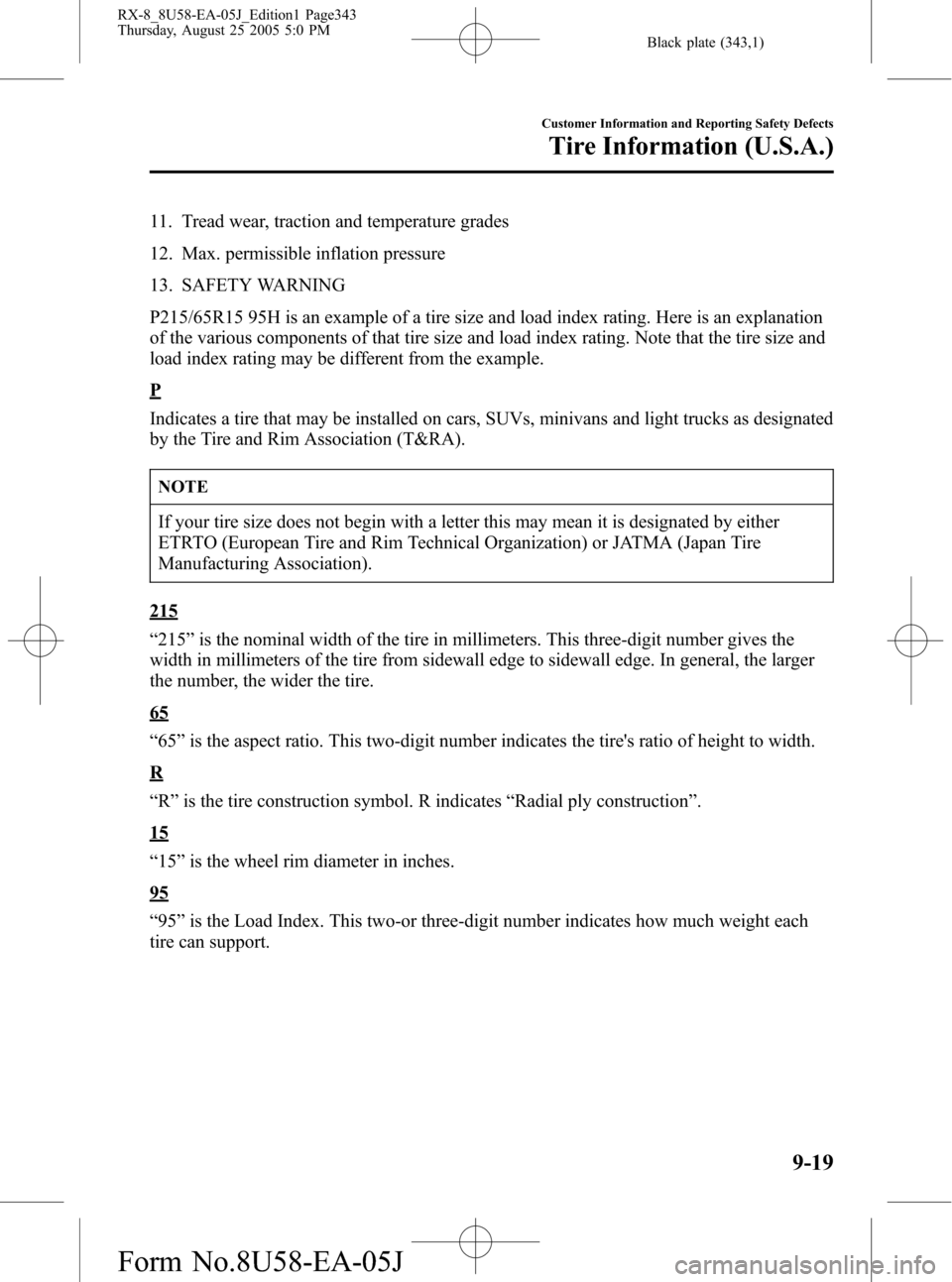
Black plate (343,1)
11. Tread wear, traction and temperature grades
12. Max. permissible inflation pressure
13. SAFETY WARNING
P215/65R15 95H is an example of a tire size and load index rating. Here is an explanation
of the various components of that tire size and load index rating. Note that the tire size and
load index rating may be different from the example.
P
Indicates a tire that may be installed on cars, SUVs, minivans and light trucks as designated
by the Tire and Rim Association (T&RA).
NOTE
If your tire size does not begin with a letter this may mean it is designated by either
ETRTO (European Tire and Rim Technical Organization) or JATMA (Japan Tire
Manufacturing Association).
215
“215”is the nominal width of the tire in millimeters. This three-digit number gives the
width in millimeters of the tire from sidewall edge to sidewall edge. In general, the larger
the number, the wider the tire.
65
“65”is the aspect ratio. This two-digit number indicates the tire's ratio of height to width.
R
“R”is the tire construction symbol. R indicates“Radial ply construction”.
15
“15”is the wheel rim diameter in inches.
95
“95”is the Load Index. This two-or three-digit number indicates how much weight each
tire can support.
Customer Information and Reporting Safety Defects
Tire Information (U.S.A.)
9-19
RX-8_8U58-EA-05J_Edition1 Page343
Thursday, August 25 2005 5:0 PM
Form No.8U58-EA-05J
Page 346 of 434

Black plate (346,1)
qInformation on Temporary Tires
Please refer to the diagram below.
1. Temporary tires
2. Nominal width of tire in millimeters
3. Ratio of height to width (aspect ratio)
4. Diagonal
5. Rim diameter code
T115/70D 16 is an example of a tire size and load index rating. Here is an explanation of
the various components of that tire size and load index rating. Note that the tire size and
load index rating may be different from the example.
T
Indicates a tire that may be installed on cars, SUVs, minivans and light trucks as designated
by the Tire and Rim Association (T&RA).
11 5
“115”is the nominal width of the tire in millimeters. This three-digit number gives the
width in millimeters of the tire from sidewall edge to sidewall edge. In general, the larger
the number, the wider the tire.
70
“70”is the aspect ratio. This two-digit number indicates the tire's ratio of height to width.
9-22
Customer Information and Reporting Safety Defects
Tire Information (U.S.A.)
RX-8_8U58-EA-05J_Edition1 Page346
Thursday, August 25 2005 5:0 PM
Form No.8U58-EA-05J
Page 369 of 434
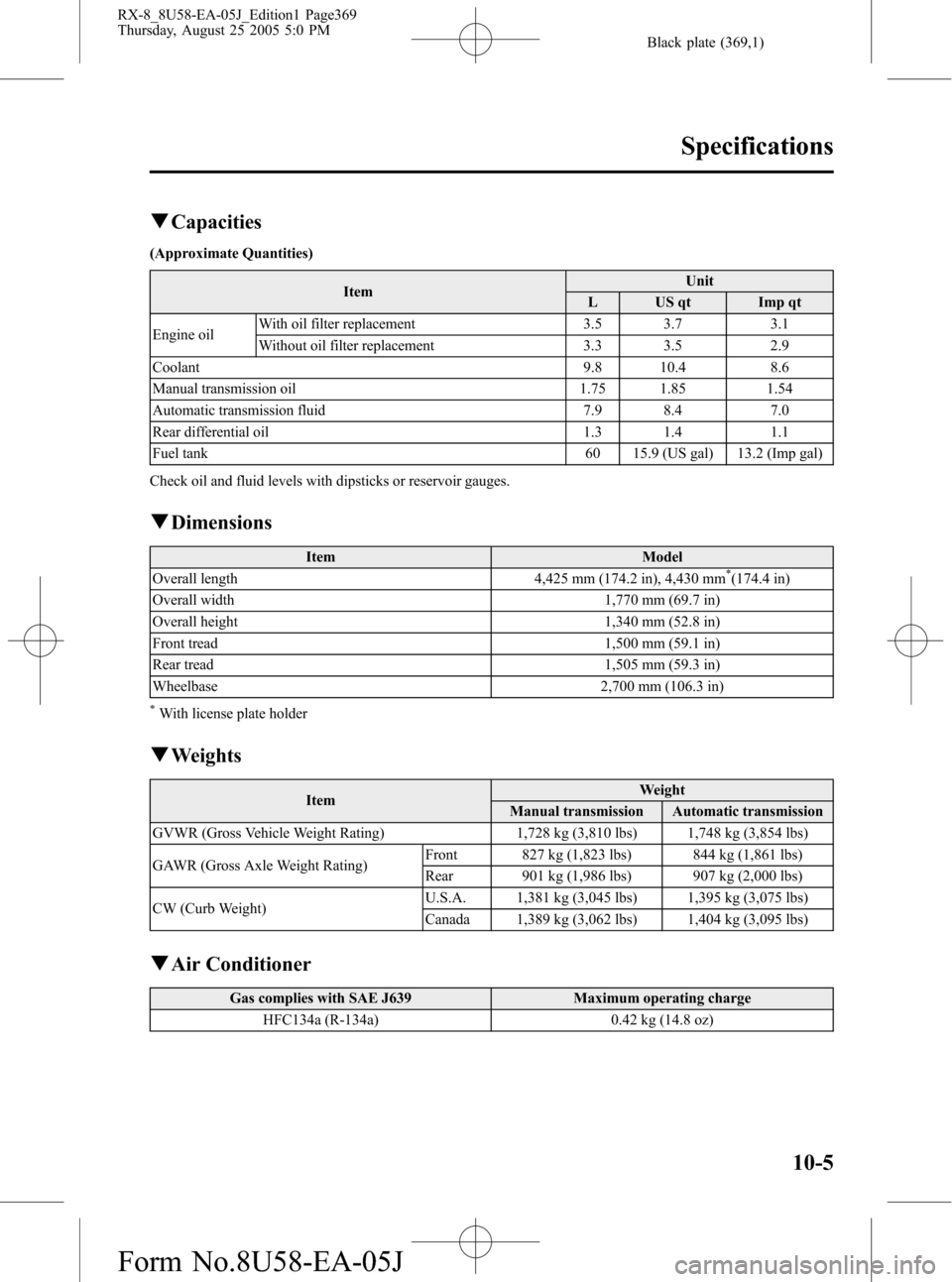
Black plate (369,1)
qCapacities
(Approximate Quantities)
ItemUnit
L US qt Imp qt
Engine oilWith oil filter replacement 3.5 3.7 3.1
Without oil filter replacement 3.3 3.5 2.9
Coolant 9.8 10.4 8.6
Manual transmission oil 1.75 1.85 1.54
Automatic transmission fluid 7.9 8.4 7.0
Rear differential oil 1.3 1.4 1.1
Fuel tank 60 15.9 (US gal) 13.2 (Imp gal)
Check oil and fluid levels with dipsticks or reservoir gauges.
qDimensions
Item Model
Overall length 4,425 mm (174.2 in), 4,430 mm*(174.4 in)
Overall width 1,770 mm (69.7 in)
Overall height 1,340 mm (52.8 in)
Front tread 1,500 mm (59.1 in)
Rear tread 1,505 mm (59.3 in)
Wheelbase 2,700 mm (106.3 in)
*With license plate holder
qWeights
ItemWeight
Manual transmission Automatic transmission
GVWR (Gross Vehicle Weight Rating) 1,728 kg (3,810 lbs) 1,748 kg (3,854 lbs)
GAWR (Gross Axle Weight Rating)Front 827 kg (1,823 lbs) 844 kg (1,861 lbs)
Rear 901 kg (1,986 lbs) 907 kg (2,000 lbs)
CW (Curb Weight)U.S.A. 1,381 kg (3,045 lbs) 1,395 kg (3,075 lbs)
Canada 1,389 kg (3,062 lbs) 1,404 kg (3,095 lbs)
qAir Conditioner
Gas complies with SAE J639 Maximum operating charge
HFC134a (R-134a) 0.42 kg (14.8 oz)
Specifications
10-5
RX-8_8U58-EA-05J_Edition1 Page369
Thursday, August 25 2005 5:0 PM
Form No.8U58-EA-05J